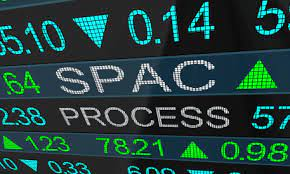
- Strategic Structuring
- Risk Mitigation
Capital Markets
- Digital Engagement
- Market Visibility
Public Perception
- Shareholders Services
- EDGAR Filings


At the heart of every Special Purpose Acquisition Company (SPAC) lies a crucial and exhilarating stage: the De-SPAC process. This key phase marks the evolution of a SPAC from its initial public offering phase to a more defined, operational public entity. It's far more than a mere formality; it's a decisive moment that reveals the SPAC's real potential and gears it up for substantial impact in the public market. Grasping the nuances of this process is essential, as it not only paves the way for fresh opportunities but also establishes a foundation for lasting success and a strong market position.
The De-SPAC process, characterized by the SPAC merging with a private company, signifies the SPAC's transition into the public trading market. This process is a fundamental component of the SPAC model, offering a unique and efficient alternative to the traditional IPO for private companies. In this process, SPACs act as crucial investment mechanisms, utilizing investor capital to facilitate this significant corporate evolution. The essence of the De-SPAC process is its ability to not only provide a streamlined path for private companies to enter the public market but also to conclude the SPAC's primary objective of acquiring a company, thereby marking a successful outcome for the SPAC.
In 2023, a relevant instance of the De-SPAC process was seen with Black Spade Acquisition Co. and VinFast Auto Pte. Ltd. Black Spade Acquisition Co., a SPAC, raised a significant amount of $400 million through its initial public offering (IPO) and placed these funds in a trust account. After the IPO, the team at Black Spade began their search for a promising private company to acquire. Their search concluded successfully when they merged with VinFast, a rapidly emerging name in the electric vehicle industry. This transaction, where Black Spade Acquisition Co. and VinFast were reorganized into a new publicly traded company named VinFast Auto Ltd, different from the original Black Spade Acquisition Co., is known as the De-SPAC.
The De-SPAC process is a multifaceted journey that requires strategic navigation to ensure a successful transition from a SPAC to a publicly traded company. This journey begins with the SPAC's initial public offering (IPO), where it raises capital specifically for acquiring a private company. The funds raised are typically placed in a trust account, earmarked for the future acquisition.
The process initiates with the identification of a potential private company, focusing on its financial health and market potential, and how well it aligns with the SPAC's strategic objectives. Utilizing tools like Crunchbase helps in gaining comprehensive insights into the target's industry position and performance, guiding a strategic selection.
Following the selection, the SPAC conducts in-depth due diligence on the target company's financial and operational status, a critical step for evaluating risks and establishing the target's valuation. The focus is on an internal analysis, which includes reviewing financial statements, operational metrics, and other key information to gain a comprehensive understanding of the company's market position and growth potential. While this phase doesn't typically involve formal regulatory filings, the insights gathered are vital for subsequent stages, informing the detailed disclosures required by regulatory bodies.
Negotiations then center on finalizing the terms of the merger, with a focus on deal structure, valuation, and future governance. Initially, the SPAC files a preliminary proxy statement (SEC Form PRE 14A) to outline the initial details of the merger. Once the terms are agreed upon, a definitive proxy statement (SEC Form DEFM14A) is filed, providing a detailed and final agreement of the merger terms.
After successful merger negotiations, the process moves to gaining shareholder approval and meeting regulatory compliance. This stage requires filing an S-4 registration statement with the SEC, which includes the definitive proxy statement and provides a full disclosure of the merger, including financial statements, risk factors, and management information.
Once shareholder approval is obtained and regulatory compliance is confirmed, the final step of executing the merger takes place. This crucial phase involves the formal consolidation of the SPAC with the target company, transitioning the private entity to public status. Typically, this results in the company being listed under a new name on the stock exchange. The completion of this step marks the successful transformation of the SPAC into a publicly traded company, signifying the culmination of the De-SPAC process.
While the De-SPAC process ideally culminates in a successful merger, as detailed in the previous contents, there are several alternative scenarios that a SPAC might encounter. These alternative outcomes, shaped by a variety of factors including market dynamics, regulatory challenges, and strategic decisions, highlight the complexities and uncertainties inherent in the SPAC structure.
In the ever-changing world of De-SPAC transactions, it's clear that the path of a SPAC is complex and demands careful strategy. Dealing with potential merger terminations, exploring liquidation options, or considering strategic changes requires flexibility and a keen understanding of both market trends and regulatory changes. Success for a SPAC isn't just about completing a merger; it's about showing strategic insight and adaptability at every step. This journey, though challenging, opens doors to significant growth and change in the public market. It underscores the need for thorough planning and smart decision-making.
SPAC deal is among 2023's largest M&A transactions - spglobal.com
 Maximizing IPO and SPAC Success: The Strategic Advantage of a Transfer Agent
Maximizing IPO and SPAC Success: The Strategic Advantage of a Transfer Agent
 How M&A Strategy Shapes the Path to IPO: Opportunities and Risks
How M&A Strategy Shapes the Path to IPO: Opportunities and Risks
 Understanding the Mechanics of a SPAC Transaction
Understanding the Mechanics of a SPAC Transaction